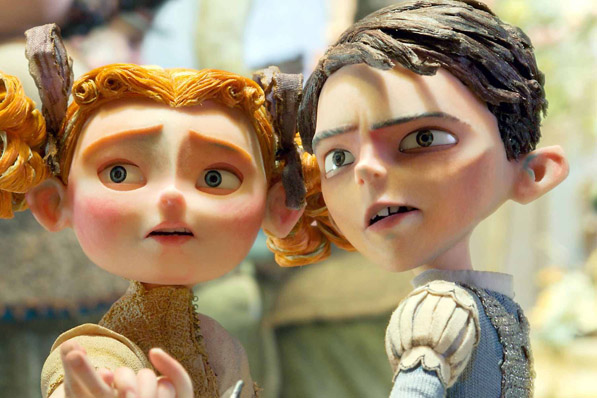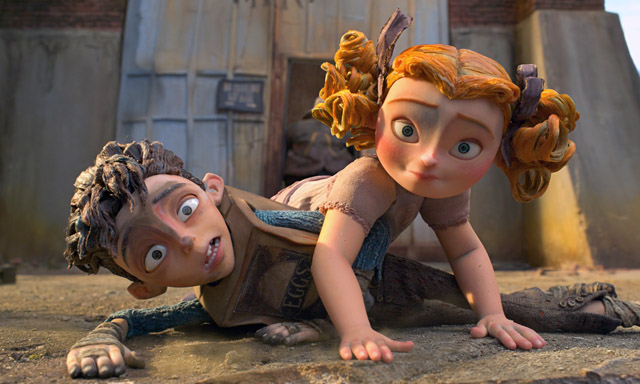Written by Ren Jender as part of our theme week on the Academy Awards.
Critics are loath to say out loud that well-made (and even some not-so-well-made) films, like the rest of pop culture, influence us in every way–fashion, language, and politics. But the proof that critics understand the political power of film comes to light in indirect ways: critics aren’t giving much publicity to the racist but groundbreaking and, in its day, critically acclaimed film, The Birth of a Nation in this, the year that marks a full century since its premiere. And since a North Carolina man shot, execution style, his Muslim, charity-minded neighbors (and a rash of anti-Muslim actions have followed) the (mostly male) cadre of critics who previously were singing the praises of American Sniper, a film that depicts Muslims as perfectly appropriate, shoot ’em up targets, stopped doing so.
Deciding what to write about The Boxtrolls (directed by Graham Annable and Anthony Stacchi), a film I enjoyed on many levels but which contains some destructively retrograde messages–mixed in with its mostly progressive ones–was difficult. I should make clear that I’m not usually an eager consumer of entertainment designed for children. I don’t have kids of my own and although I liked the one Harry Potter book I’ve read I never felt the need to read the others. But The Boxtrolls is beautiful to look at (and comes from LAIKA, the same folks who gave us Coraline)–stop-motion animation set in a steam-punk version of 19th century England. With a great deal of economy (the clever script by Irena Brignull, Phil Dale, Adam Pava, and Anthony Stacchi is based on the book, Here Be Monsters! by Alan Snow) the film sets up the premise: boxtrolls, small monster-like creatures who get their name from the cardboard boxes they wear and draw themselves into, turtle-like, at the first sign of danger, scavenge the town streets at night for scraps and goods they can take to their underground lair. Archibald Snatcher (played, magnificently, by Ben Kingsley–it’s the best role he’s had since Sexy Beast; he should play villains more often!) is an opportunistic striver who seeks to elevate his station, first by demonizing the harmless boxtrolls and then capturing all of them, making the streets “safe” for the townspeople and collecting his reward from the town’s ruling elite, headed by Lord Portley-Rind (voiced by Jared Harris) who resembles the king in a deck of cards and has about as much depth.
In a nice contrast to many children’s films and books, the character at the start who goes against the mob is a girl, Lord Portley-Rind’s daughter, Winnie (voiced by Elle Fanning in a mid-Atlantic accent passing as British). Although Winnie, in her pink ruffled dress and blonde ringlets might look like other storybook heroines, her fits over never being believed or taken seriously by adults and her morbid fascination with the boxtrolls make her more like Daria than Alice in Wonderland. When she asks another character if boxtrolls ate his parents, she adds, “Did they let you, I mean, make you, watch?”
Winnie’s curiosity about the boxtrolls ends up with her encountering them in their own lair–and meeting Eggs, named after the box he wears, (and voiced by Isaac Hempstead Wright) a human boy adopted by the boxtrolls who doesn’t realize he’s not one of them, though he’s twice their height. After he disavows all the ways he is different from his adopted kin he can’t really argue when Winnie suggests, “Then let’s see you fit in your box.”

The two work together to try to stop the machinations of Snatcher (whose name, manner and appearance seem to be a tribute to the “child catcher” in Chitty Chitty Bang Bang) though as in most films, the boy takes on the main role in vanquishing the villain. In spite of how vivid the animators and Fanning make Winnie, this film does not even come close to passing the Bechdel test. One of the few women characters, Winnie’s mother, is played by the great Toni Collette but she barely gets a line in. And the boxtrolls must reproduce by cloning because we never see one who’s female.
But the huge problem at the center of The Boxtrolls are the scenes when the screenwriters, to show how propaganda can influence the actions of otherwise reasonable people, have Snatcher put on a corset and an evening dress and assume an alter-ego, a red-haired, French chanteuse who sexily sings about killing boxtrolls while she charms all the men in town (who don’t seem to see beyond the wig). I’ve written before about the history of murderous trans* women in film but I was particularly surprised to find this trope–along with the one in which a trans* woman hides her identity and the men who were attracted to her are chagrined once she is outed–in a film that aggressively courts a progressive audience.
Not only is The Boxtrolls full of messages about not dehumanizing those who are “different,” and that adoptive families are just as loving as other families, but it also has kind of an Occupy moment when its boy hero tell others, “Stand up for yourselves. Don’t be afraid anymore.” At the end of the film over the credits we hear “The Boxtrolls Song” an explicitly pro-queer-family anthem by Eric Idle (of Monty Python fame) that includes in its laundry list of different kinds of families those with two Moms or two Dads.
I was sad that this otherwise delightful, humorous (some of Kingley’s lines made me laugh like I haven’t since Obvious Child), anti-capitalist film nominated for a Best Animated Feature Oscar had to pollute itself with “man in a dress” jokes, especially considering that these jokes couldn’t be mere throwaways–stop-motion films take years of painstaking effort to create (which could also explain the “Occupy” theme). I wondered if anyone involved in the film knew that a generation ago, making fun of the rest of the queer community would have been considered acceptable children’s entertainment too.
[youtube_sc url=”https://www.youtube.com/watch?v=Q2dFVnp5K0o” iv_load_policy=”3″]
Ren Jender is a queer writer-performer/producer putting a film together. Her writing. besides appearing every week on Bitch Flicks, has also been published in The Toast, RH Reality Check, xoJane and the Feminist Wire. You can follow her on Twitter @renjender









